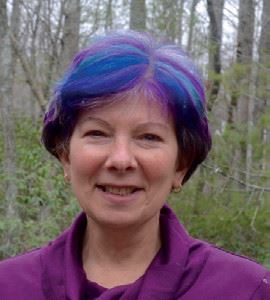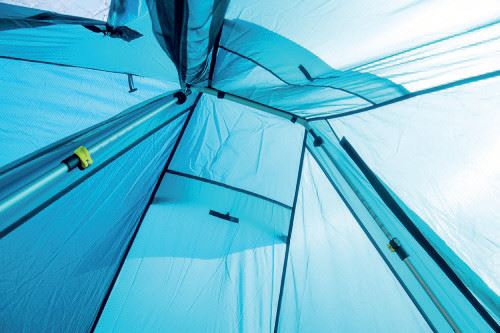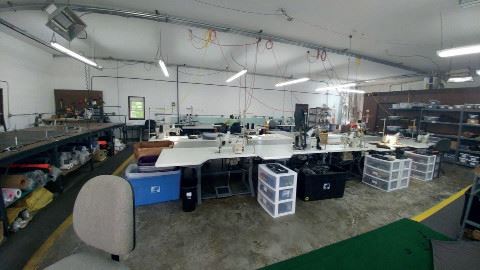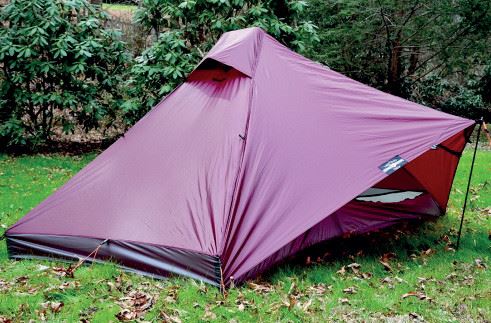Judy Gross, LightHeart Gear/Excelsior Sewing LLC--Asheville, NC
Where is your business located? Do you work out of a home studio or do you have a brick and mortar location?
 Excelsior Sewing – the parent company of LightHeart Gear is located in the beautiful Southern Appalachian Mountains of Asheville, North Carolina. We have a “brick and mortar” factory of 2400 square feet, but we’re searching for a location with two to three times more room that we can purchase. I also have a wonderful sewing room/studio at home, but I almost never go there anymore. After 8 hours in the factory, I don’t want to sew at home. What I like the most about my home studio, is that when I turn off the light switch as I’m leaving the room – it turns off all the machines and the iron, so I never have to worry about having left the iron on.
Excelsior Sewing – the parent company of LightHeart Gear is located in the beautiful Southern Appalachian Mountains of Asheville, North Carolina. We have a “brick and mortar” factory of 2400 square feet, but we’re searching for a location with two to three times more room that we can purchase. I also have a wonderful sewing room/studio at home, but I almost never go there anymore. After 8 hours in the factory, I don’t want to sew at home. What I like the most about my home studio, is that when I turn off the light switch as I’m leaving the room – it turns off all the machines and the iron, so I never have to worry about having left the iron on.
What kind of work do you specialize in?
 Excelsior Sewing does small batch contract / production sewing, primarily outdoor gear, as well as all the manufacturing for LightHeart Gear, my own backpacking gear company. I personally do all the design and pattern work. I do all the cutting, and have several employees that do the sewing. We sew things such as ponchos, tarps, chair backs, bicycle bags, tents, and rain gear. Our goal in the contract sewing is to help other small businesses keep their products “Made in the USA”. Small batch production helps small business keep their revenue stream fluid.
Excelsior Sewing does small batch contract / production sewing, primarily outdoor gear, as well as all the manufacturing for LightHeart Gear, my own backpacking gear company. I personally do all the design and pattern work. I do all the cutting, and have several employees that do the sewing. We sew things such as ponchos, tarps, chair backs, bicycle bags, tents, and rain gear. Our goal in the contract sewing is to help other small businesses keep their products “Made in the USA”. Small batch production helps small business keep their revenue stream fluid.
Tell me a little about your favorite part of your sewing space.
 The space works. What that means is that the organization and layout provides the right setting for the work that is done. And of course, I love all the different specialized machines. A funny story is that when I was in design school, thinking of going into business doing bridal, I had some of the top of the line home sewing machines (Bernina and Viking). I remember telling my instructor at school that I didn’t want to work on the industrial sewing machines they had – because I had fancy machines that could do everything. Now, I own about 15 or so industrial machines. Each does just one specific thing, but it does it perfectly. I do keep one of my old Berninas at the shop to repair window netting on the tents. I use the 3-step zigzag stitch as I don’t have an industrial zigzag machine.
The space works. What that means is that the organization and layout provides the right setting for the work that is done. And of course, I love all the different specialized machines. A funny story is that when I was in design school, thinking of going into business doing bridal, I had some of the top of the line home sewing machines (Bernina and Viking). I remember telling my instructor at school that I didn’t want to work on the industrial sewing machines they had – because I had fancy machines that could do everything. Now, I own about 15 or so industrial machines. Each does just one specific thing, but it does it perfectly. I do keep one of my old Berninas at the shop to repair window netting on the tents. I use the 3-step zigzag stitch as I don’t have an industrial zigzag machine.
Do you work alone or do you share the space with others?
I have several employees that do most of the sewing. My time is spent designing, cutting, planning, and running a business (QuickBooks is my nemesis) but not in that order. My attitude is that I work for my employees, so anything I can do to facilitate their work is my job. I do the little things to keep them sewing. I do pitch in on sewing when we are in a rush to get an order out, or when I decide to practice avoidance. It’s a real treat for me to get to sit at a sewing machine, but I find that if I’m spending a lot of time sewing, it’s probably time to hire a new employee.
How did you develop your layout?
Workflow is very important, and must go in an organized manner. Machines are grouped by task and frequency of use. We also have to have large work space/surface area around all of the machines because we often work on very large pieces of fabric. We have lots of tables between, and around all of the machines that can be shifted as needed for specific jobs. Each machine or station has its own small stack of drawers that contain all the different types and colors of thread, needles in several sizes, different presser feet for the machine, snips, screw drivers, labels, and any other items needed at that location. This duplication allows employees to move from station to station and not worry about bringing items with her/him. Problems with the set up only arise when we get in new equipment. Trying to figure out the best place to put it can entail shifting a bunch of heavy machines around. Most of the machines plug into outlets in the (high) ceiling, so moving machines means getting a big ladder out to unplug machines, hope that the cords reach from the new location, and shift again if they don’t. Floor space has become a premium as the shop gets more and more machines in.
What's the first thing that clients notice about your space?
My clients are usually companies looking to have items sewn for them. Often, they are surprised by how much we can produce with such a small staff. They may never have seen a sewing factory before, and are amazed at the different equipment. We occasionally get a customer for LightHeart Gear that comes to visit. They are usually amazed at just being in a sewing factory, the amount of specialized equipment, the piles of partially constructed items that are mounded in buckets and hampers. My space is not “pretty,” it’s industrial.
What makes your sewing space unique?
 I don’t know that there is anything truly unique about Excelsior Sewing. We do have places in the shop to set up tents – Occasionally because we have customers interested in seeing and buying tents, but mostly because they have to be inspected, and seam sealed. The fabric we use cannot be ‘taped’ as the fabric has a silicone coating on it to make it waterproof. Seam sealing is done with a liquid silicone mixture. Each tent has to be individually set up to seam seal. Once the items for LightHeart Gear and finished and packed, they leave the shop and go to our distribution center (my basement at home). From there, they are packed and shipped to customers that order on our website www.lightheartgear.com.
I don’t know that there is anything truly unique about Excelsior Sewing. We do have places in the shop to set up tents – Occasionally because we have customers interested in seeing and buying tents, but mostly because they have to be inspected, and seam sealed. The fabric we use cannot be ‘taped’ as the fabric has a silicone coating on it to make it waterproof. Seam sealing is done with a liquid silicone mixture. Each tent has to be individually set up to seam seal. Once the items for LightHeart Gear and finished and packed, they leave the shop and go to our distribution center (my basement at home). From there, they are packed and shipped to customers that order on our website www.lightheartgear.com.